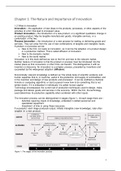Chapter 1: The Nature and Importance of Innovation
1.2 What Is Innovation
Innovation = the application of new ideas to the products, processes, or other aspects of the
activities of a firm that lead to increased value.
Product innovation = the introduction of a new product, or a significant qualitative change in
an existing product. May be tangible manufactured goods, intangible services, or a
combination of the two.
Process innovation = the introduction of a new process for making or delivering goods and
services. They can arise from the use of new combinations of tangible and intangible inputs.
A product or a process can be:
New to the firm; not really an innovation, as it can be the adoption of a product design
or a production method. This is called diffusion of innovation.
New to the domestic market
New to the world market.
Innovation is in this book defined as new to the firm and new to the relevant market.
Another feature of innovation is that the product or process must be introduced into the
market place so that consumers or other firms can benefit. This distinguishes it with an
invention or discovery. An innovation is a complex process, preceded by inventions and
succeeded by the widespread adoption (diffusion).
Economically relevant knowledge is defined as “the whole body of scientific evidence and
human expertise that is, or could be, useful in the production and supply of commodities and
in the invention and design of new products and processes”. It can be codified (a chemical
formula or computing algorithm) or tacit (a person know how to do something that is not
written down). If it is embodied in individuals it is called human capital.
Technology encompasses the current set of production techniques used to design, make,
package and deliver goods and services in the economy. Within the firm, the technology
used determines its productive capability when combined with other inputs.
The innovation process can be distinguished in stages (figure 1). At each stage there are: -
- Activities requiring inputs of knowledge, embodied in skilled personnel and
specialized equipment.
- Investment of time in using these resources.
If successful, each stage produces output, initially intangible (new knowledge), later often
tangible (in a new product).
Figure 1: The stages of the innovation process
1
,In the first 3 stages the inventions are being made by a verity of agents, including public
scientific institution, universities, lone inventors and firms. There is feedback between the
various stages: innovation is rarely a linear progression through the stages shown. The
stages are not always conducted in the same firm.
An incremental innovation only makes a small change to an existing product or process.
A drastic or radical innovation introduces a completely new type of production process with
a wide range of applications and gives rise to a whole new genre of innovative products.
1.3 The Macroeconomic Effects of Innovation
Product innovation and process innovation are not completely independent as the
introduction of a new process permits the design and development of a range of new
products, while the introduction of a new intermediate product permits a purchasing firm to
change its production process. For the moment though, they are considered as of a different
nature.
Market structure refers to the nature of competition between the firms in the market. The two
polar cases are the perfect competition and the monopoly.
Process Innovation in a perfectly competitive market
The consumer surplus is the measure of benefits
for consumers. The process innovation is
assumed to:
- Reduce the average or marginal cost of
production (in this example from 𝑀𝐶1 = 𝐴𝐶1 to
𝑀𝐶2 = 𝐴𝐶2 )
- Reduce the price for consumers (from 𝑃1 to 𝑃2 )
- Rise the consumer surplus
Figure 2
In perfectly competitive markets with immediate knowledge diffusion, there is no financial
incentive to develop a process innovation. Because of patents there is and an innovator can
produce and sell products for a price of 𝑃1 -ɛ (where ɛ is very small). The profits it could make
are approximately: (𝑃1 - ɛ - 𝐴𝐶2 )* 𝑄1 .
Process Innovation for a monopoly
A monopoly will maximize it profit by producing
where the marginal revenue (MR) =𝑀𝐶1 . The
profits in this situation are (𝑃3 − 𝐴𝐶1 ) ∗ 𝑄3 . With
process innovation the marginal costs can be
reduced to 𝑀𝐶2 , which leads to:
A lower consumer price (𝑃4 )
More output (𝑄4 )
A higher consumer surplus
Higher profits.
There is assumed that monopolists will always
Figure 3 seek to maximize profits.
Product innovation
Without IPRs there would be no gain for the innovator to develop a new product. However,
most of the time there is some form of IPR, secrecy or first-mover advantages to delay
imitation. The product is than acting as a monopoly (see figure 4).
2
, The elasticity and position depend on the
value, which in turn depends on the availability
of substitute products. As 𝑃1 >𝑀𝐶1 , the
consumer surplus is not maximized (then it
would occur at Q*). Some of the lost consumer
surplus has become profits to the innovator
(ABCD), but some is wasted (BDE). This area
is called ‘deadweight loss’.
It is also possible that the product innovation
Figure 5 creates only a new variety or an improvement
in quality. Suppose the market was already
Figure 4 imperfectly competitive, by introducing a new
product variety or improvement, the firm aims
to achieve an outward shift and steeper slope to the demand for its product (see figure 5).
Although consumers are charged at a higher price, they buy more and their surplus is higher.
Figure 5
Box 1.2. Leontief’s input-output flow matrix.
The Leontief input-output matrix is a way of visualizing how an economy is integrated. Take
manufacturing sector M and service sector S. Their intermediate goods, used by the other
are (𝐴𝑀𝑆 & 𝐴𝑆𝑀 ). They also use part of their own output as input (𝐴𝑀𝑀 & 𝐴𝑆𝑆 ). The gross
output X (= 𝑋𝑀 + 𝑋𝑆 ), is therefore bigger than the net output for the final demand F (= 𝐹𝑀 +
𝐹𝑆 ).
Furthermore, the final demand is divided between
consumption C and investment I.
𝐹𝑀 = 𝐶𝑀 + 𝐼𝑀
𝐹𝑆 = 𝐶𝑆 + 𝐼𝑆
Investment in each sector involves also the
purchase of some of other sector’s output (𝐵𝑀𝑆 & 𝐵𝑆𝑀 ) and the use of its own final output
(𝐵𝑀𝑀 & 𝐵𝑆𝑆 ).
Every process innovation causes lower costs of
inputs and every product innovation causes new
product varieties, both for user firms. They can
lead to new processes of production, due to new
intermediate products A, new investment products
B or cost changes.
1.4 Interaction between Producers and Users of Innovation
The Leontief model already mentions a relationship between the producers and the users of
innovations. Users give feedback information about the product’s performance on many
moments. With this feedback the next generation products is created.
Pavitt (1984): created a taxonomy of sectoral patterns of technical change and identified 4
distinct groups of industries in terms of their technology acquisition & use:
Supplier dominated: importing new elements of process technology, but making little
contribution via in-house R&D.
3
, Scale intensive producers: contribute a lot of their own innovations and work these
into profit through the operation of large-scale production processes.
Specialized suppliers: main focus is the generation of product innovation in
intermediate goods or capital equipment for use in other sectors.
Science-based sectors: firms engage intensively in in-house R&D based on
advances in universities and public research institutions.
Later (2001) the categorization was refined and extended with information intensive
firms (finance, retail and publishing).
In 2006 there came a 6 category: software-related companies.
th
1.5 Innovations and Market Failure
If the firm cannot charge all the beneficiaries of its innovation, there is a problem of matching
incentives to the value of the activity, which may lead to an undersupply of innovations. The
possibility that the market systems will not lead to the optimal outcome is called market
failure. Four cases are considered.
Case 1: Is New Knowledge a Public Good?
The defining characteristic of a public good is that it is nonrival, which means that any single
use of the good does not affect its availability to other users (e.g. a service by the
government). It can be used simultaneously by many people. A public good may also be
nonexcludable: its use by one party still implies access for all (pure public good).
Once a nonrival public good has been provided or discovered in the case of knowledge, the
marginal cost of an extra user is zero. As resources are allocated most efficiently when
prices are equated to the marginal costs, there will be a loss in efficiency and exclusion of
potential users, or the price is zero and private firms will not produce or develop it. In the
commercial world, the value of new knowledge can be rival, even though the knowledge itself
is intrinsically nonrival. Knowledge can also not be nonrival with IRP’s or secrecy.
Case 2: Are There Externalities from Innovative Activity?
Production externalities arise when the profit-seeking activities of one firm create positive or
negative effects for other firms, and where these side effects are not priced and cannot be
sold through the market. In the innovation process (figure 1), basic research has the nature
of a public good, because its applications can be in different fields. It is hard to suppress it or
keep it secret, as the knowledge is likely to be nonexcludable. In contrast, when getting to
the point of a particular application of knowledge, a specific innovation is closer to supplying
a private good with externalities.
Case 3: Indivisibilities, Uncertainty, and Capital Markets
Indivisibility is the idea that a project cannot be broken down into smaller, more
manageable units. It means that the project has high fixed costs, which may be a barrier to
undertake the project. If there are large fixed costs in creating knowledge, but small marginal
costs in supplying, competitive market pricing seems unlikely (e.g. creation of new software).
Uncertainty is inherent in the innovation process, as decisions to bear risk by doing R&D
cannot be separated as an element of choice from decisions to wait for returns. This is
because there is no insurance possible. If capital markets worked perfectly these two
problems could be solved, as investors would correctly evaluate the expected value and
would diversify their portfolios. However, finding the best projects is difficult and it is costly to
fully evaluate a project.
Case 4: Patent Races and Duplication
The last market failure concerns the fact that firms compete to make exactly the same
innovation. There may be duplication of R&D. It is characterized as a patent race, with the
implication that the winner takes all of the returns. However, R&D in common fields is often
necessary to engage in exchange of information and technology.
4






